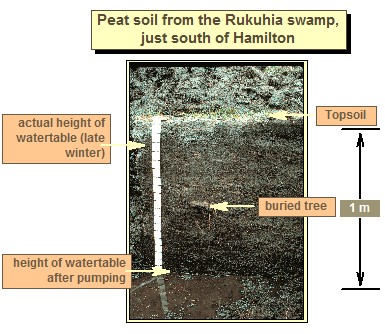Soil is not simply a mixture of the five soil forming factors.
Because soil colour, texture, consistency and structure usually vary together with depth, a vertical face of exposed soil often appears as approximately horizontal layers. These layers or horizons together constitute a soil profile. It is this profile from the ground surface to the lower subsoil that is referred to as a soil.
Road cuttings often expose horizons in the soil, showing how soil properties change with depth and location.
If soil forming factors were precisely the same for all parts of the earth, then the soils of the world would all be expected to be exactly the same.
However, even over very short distances one or more factors can change, often quite dramatically.
As a result, the chemical, physical and biological properties as well as the appearance of soils vary from place to place.
Soil Forming Factors: Waikato Soils Example:
A brief look at the soils of a region such as the Waikato illustrates how and why soils can vary:
This soil profile was taken in late winter. The very high water table is typical of peat soils.
This soil shrinks in summer as the water table drops. Drainage has permanently lowered the water table, enabling the uppermost peat layer to become aerobic.
Decomposer action now allows the organic matter to break down to form gases such as CO2. As matter 'gases off' the volume of the soil continues to reduce. Currently, Rukuhia soil is dropping in height 10-20 mm per year.

 |
many of the mineral soils found in the Waikato around Hamilton City are relatively young (<12,000 years old), so soil forming materials have had time to alter only slightly. Parent materials, therefore, usually dominate soil properties.
|
 |
most of the mineral soils in the Waikato lowlands are formed from alluvium, making soil textures highly variable, ranging from gravel to clay even within a single profile
|
 |
soils formed on ridges under well drained conditions differ from those formed in lower, poorly drained areas
|
 |
peat, characteristic of certain areas within the Waikato, forms organic soils. Around the edges of peat swamps soils often have peaty tops on a mineral subsoil.
|
The tree has remained buried but has not rotted because of the anaerobic conditions and the very low pH. The tree was buried 1650 ± 60 years ago. This date can be determined so accurately through:
 |
fertilisers - natural nutrient status is extremely low
|
 |
lime - pH of this soil in the natural state is about 4.0. (A pH of 4 is about the same as is found in an orange).
|
Effectively, this soil has no topsoil. Farming is only possible by continual inputs of:
 |
radioactive carbon dating
|
 |
the tree lies buried very close to a layer of Taupo volcanic ash - the date of the Taupo eruption is documented 'precisely' in history
|
Horizon Layers
The soil is composed of horizontal zones or layers known as soil horizons. Together, these horizons form the soil profile.
For further detail on Waikato Soil Orders and Groups: refer to Classifying Soils: section Waikato Soils Example and Example Waikato Soil Groups and Series